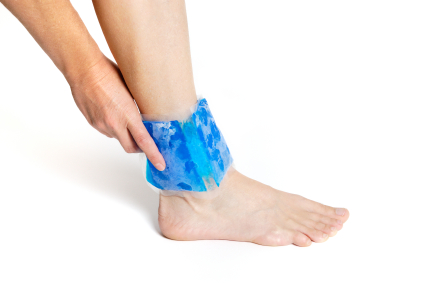When to treat with HEAT: Heat treatment (or thermotherapy) relieves stiffness and chronic aches, facilitates relaxation, and stimulates circulation. It works by increasing tissue temperatures and blood flow, thereby drawing extra nutrients into the area to assist in the recovery and healing process.
When not to use HEAT: Heat should never be used on acute injuries until the swelling is controlled. Heat draws fluids into tissues and can increase swelling and inflammation. Do not use heat over swollen tissues or redness except under the supervision of your health care practitioner. Do not us e heat before vigorous exercise. Your muscles may be too relaxed for peak performance and safety.
e heat before vigorous exercise. Your muscles may be too relaxed for peak performance and safety.
Application: Typical treatment times for heat applications are between fifteen and twenty minutes. It takes heat a minimum of fifteen minutes to penetrate tissues to reach therapeutic temperatures. Moist heat penetrates more deeply than dry heat and will not dehydrate tissues so circulation is improved, speeding healing. For moist heat when using dry packs (e.g., gel packs) add a layer of moist toweling.
When to treat with ICE: Cold therapy (or cryotherapy) is the treatment of choice for acute injuries. When applied immediately after an injury, cold treatment reduces tissue damage by reducing the metabolic rate and decreasing the production of metabolites and metabolic heat which result from the body's inflammatory response to the injury. Cold therapy also relieves muscle spasms, reduces post-exercise soreness, and stimulates circulation in areas of chronic discomfort. Cold therapy can be applied with ice packs, cold and ice whirlpools, ice massage, commercial cold sprays.
When not to use cold: Do not use over insensitive skin or in the presence of poor circulation. Elderly people, young children, and people with diabetes must be very careful with cold treatments. If you have any questions about cold therapy, ask your health care practitioner for advice.
Application: The first 72 hours after an acute trauma or subacute injury, you should only use cold treatments. Treatment time varies depending on several factors, including the size of the treatment area, the type of cold therapy applied, and the size of the individual. For example, a thin person requires less treatment time because the cold does not need to penetrate through as much tissue to lower intramuscular temperatures. You'll know when you've had the cold on long enough, by monitoring the four stages of cold treatment: The first stage is an uncomfortable feeling; the second stage is a stinging sensation; the third stage is burning or aching; the fourth stage is numbness. It takes five to fifteen minutes to reach all four stages. For acute injuries, apply cold immediately for a minimum of 10 to 20 minutes. Some folks keep the cold application on for an hour or more. Repeat the cold application every few hours for the first 4 to 72 hours after an injury. To reduce post-exercise soreness, apply cold immediately after exercise for 10 to 20 minutes. For chronic discomfort, apply cold for a minimum of 10 minutes. Repeat as necessary. If you suffer from "ice burn" or "ice allergy" when you are exposed to cold, wrap the cold pack with a damp towel. Follow packaged instructions carefully. Ice can burns or damage tissues if used improperly.